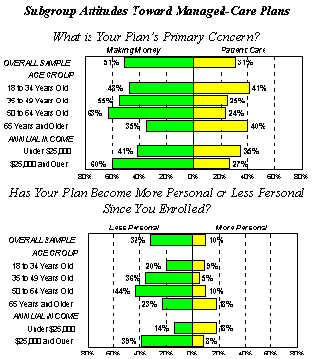![]()
Arizonans Critical Of The Service They Receive From Managed Care Plans
Most adults enrolled in managed healthcare statewide said they believe plans are more interested in making money than in the quality of care patients receive. In addition, Arizona enrollees are more likely to believe—by a three-to-one margin—that the quality of service and care they receive from their managed-care organizations has become less personal, rather than more personal, since they first enrolled. Both of these results come from the latest O’Neil Associates Valley Healthcare Monitor, which asked the following questions of 269 Arizona adults who are currently enrolled in managed healthcare plans:

Do you think your managed-care organization is more concerned with the health care its patients receive or with making money?
Do you think the care you receive from your managed-care organization has become more personal, less personal, or stayed about the same since you first enrolled?
In response to the first of these questions, just over half (51%) of all respondents said they believe their managed-care plan is more interested in making money, compared to less than one third (31%), who believe it is more interested in patient care.
The remaining respondents have no firm opinion either way: nine percent said their plans are equally concerned with making money and with patient care, and another nine percent answered "don’t know."
Respondents’ moderate dissatisfaction with their current managed-care organizations is also evident in their responses to our second question, which concerns any changes in the personalization of the service and care they have received since first enrolling. Most people (55%) said they have experienced no noteworthy change in the service they have received; it is now just as personal (or impersonal) as it was when they first joined their respective plans. That leaves, however, more than two fifths who said they have noticed significant change: 32 percent who believe this change has been in the direction of becoming "less personal" compared to only 10 percent who believe their care has become "more personal." In other words, among those respondents who believe there has been substantial change in the level of personalization in the health care they receive, the vast majority of these believe this change has been for the worse.
These attitudes toward managed care are generally consistent across different regions of the state, but as is demonstrated in the chart above, we did find some interesting contrasts according to respondent age and household-income level. For example, both the youngest and the oldest respondents have views of their managed-care organizations that are somewhat more favorable than the views expressed by their medium-aged counterparts. Specifically, two fifths of the respondents between the ages of 18 and 34 or age 65 years or older said they believe their managed-care organization is more concerned with patient care than with the bottom line; in contrast, only one fourth of those between the ages of 35 and 64 believe that is the case. Likewise, lower-income respondents tend to be more generous in their attitudes toward their managed-care organizations than are respondents from households that bring in more than $25,000 per year. For example, lower-income respondents are actually slightly more likely to believe their care has become more personal (18%) rather than less personal (14%) since they first enrolled, while the collective opinion expressed by high- and medium-income respondents is decidedly more negative: 39 percent said their care has become less personal versus only eight percent who believe it has become more personal.
These results are based on 459 interviews we conducted with randomly selected heads of household in metropolitan Phoenix. The "sampling error" associated with a survey of this size is approximately ±4.6 percent. This means that the chances are approximately 95 in 100 that we would have obtained the same results, within a margin of ±4.6%, had we interviewed every adult resident of Maricopa County.